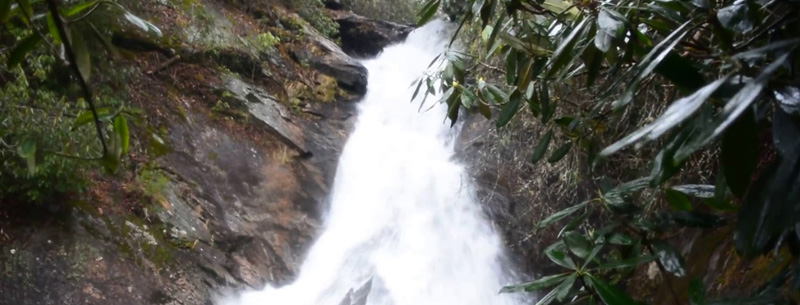The Ellicott Rock Wilderness is located where the borders of North Carolina, South Carolina, and Georgia meet. Sections lie within the Nantahala, Chattahoochee, and Sumter National Forests. While the area has felt the impact of humans in the past, these second-growth forests are now reaching the impressive size and natural appearance, following logging which occurred before the Forest Service purchased the land.
The mountainous terrain ranges in elevation from 1,240 feet along the southeastern boundary by the Chattooga river to 3,672 feet on Glade Mountain. This steep terrain offers breathtaking cliffs and waterfalls. White pine and hemlock trees cover many lower coves and streamsides, while upland hardwoods grow on slopes, and on dry ridges scrub oaks and pitch pines are common.
While the cooler climate offers relief from the hotter portions of South Carolina, Ellicott Rock Wilderness lies just south of the highest rainfall area in the United States, averaging 80 inches per year, so come prepared for wet weather.
History of the Ellicott Rock Wilderness
Wilderness, as described in the 1964 Wilderness Act, is”an area where the earth and its community of life are untrammeled by man, where man himself is a visitor who does not remain.” The act directs that these areas be managed to “secure for the American people… and future generations the benefits of an enduring resource of wilderness.. .unimpaired for future use and enjoyment.” A wilderness “shall be devoted to the public purposes of recreational, scenic, scientific, educational, conservation, and historical use.”
Congress established the 3,300 acre Ellicott Rock Wilderness in 1975 and made additions in 1984 so that it now contains 9,012 acres in North Carolina, South Carolina, and Georgia. The wilderness straddles the 15,432 acre Chattooga Wild and Scenic River Corridor, providing a large undeveloped land area within easy driving distance for millions of Americans.
Andrew Ellicott, a noted surveyor, was commissioned by North Carolina and Georgia to determine the boundary between the states. He completed his survey in 1811 by chiseling an inconspicuous mark on a rock on the east bank of the Chattooga River. This rock can still be found today inside the Ellicott Rock Wilderness.
The Southeastern National Forests boast 74 National Forest Wilderness Areas, totaling 670,000 acres. They protect an extraordinary range of natural ecosystems, offer prime recreational opportunities, contain stunning vistas, and high-quality streams, among other treasured outdoor values. The designation of these diverse areas is a major conservation achievement. It required the combined efforts of concerned citizens and local, state, and federal officials, among others. The 1964 Wilderness Act proudly celebrated its 30th Anniversary in 1994.
Special Hazards
If you become lost, remember that you are always within a few miles of a road. In the Ellicott Rock Wilderness or near the Chattooga River, you should travel downhill or downstream. During the summer, you can usually find other people near streams. If a group member becomes lost, remember how the person was dressed and where the person was last seen.
Thieves may steal wallets, cameras, or expensive gear if you leave them in your car during visits to the forest. Reduce opportunities for crime. Locked cars and trunks are not completely safe; leave unnecessary equipment at home and carry valuables with you.
Restrictions
Campers may select their own sites within the Ellicott Rock Wilderness, provided the site is at least 50 feet from the trail, 50 feet from the river or any stream, and 1/4-mile from the road.
To maintain the wilderness experience and natural resources, we are asking all groups to limit their size to 6 people within the Ellicott Rock Wilderness. On all National Forest land, groups with more than 24 participants must have a Special Use Permit.
All commercial activities on National Forest land require a Special Use Permit. Commercial activity is any activity where the organizer or any of his employees makes a profit and/or receives a monetary reimbursement or other compensation for services or supplies provided on National Forest land. An activity is not commercial if there is a bona fide sharing of expenses and no fee, charge, or another compensation is collected from individual participants in excess of expenses incurred.
Horses are prohibited on hiking trails.
Motorized vehicles and bicycles are prohibited in the wilderness.
To preserve Nature’s ground cover, pick a campsite where you won’t need to clear vegetation or ditch around your tent. Nails, knives, and hatchets injure and kill trees,. Hot lanterns hung on trees cause severe damage.
If you must have a campfire, please keep it safe and small! Use an existing fire ring, rather than building a new one. Clear the ground to mineral soil. Use only downed wood. Drown with water and stir. Scatter cold ashes and rocks used for your fire ring in the woods before leaving. To cause the least impact, use a backpacking stove.
Human Waste: Use the”cat method” of making a shallow hole and covering when done. The hole should be dug at least 200 feet away from camps, trails, and streams.
Most use occurs on weekends. By camping during the week or in the spring and fall, you will see more NATURE and fewer PEOPLE. The areas along the Chattooga River are especially crowded on weekends. The Foothills Trail between Sloan Bridge and Burrells Ford provides better opportunities for solitude.
Fish are not stocked within the wilderness. Practicing “Catch and Release” may increase the number and size of fish that you catch on your next trip.
